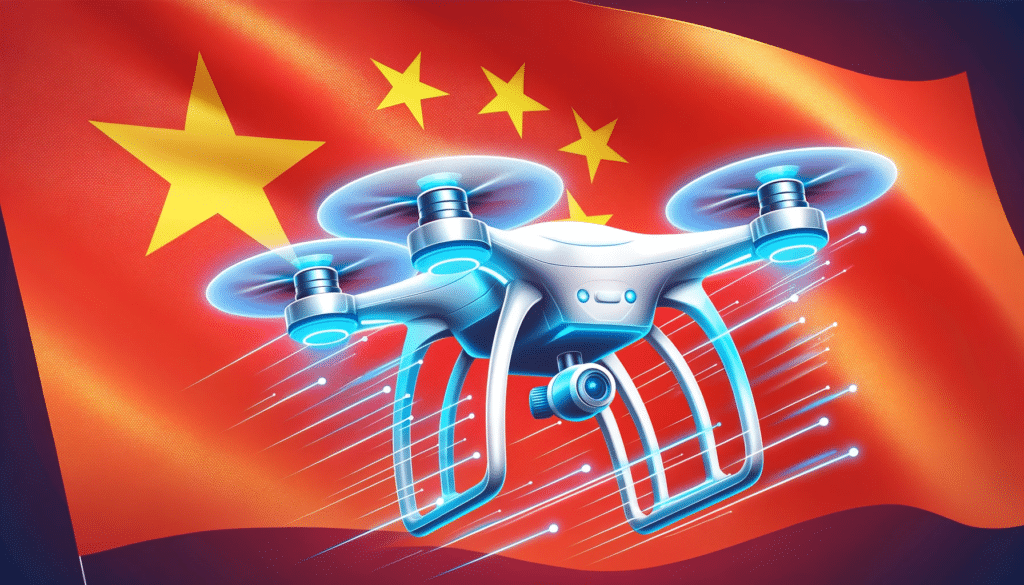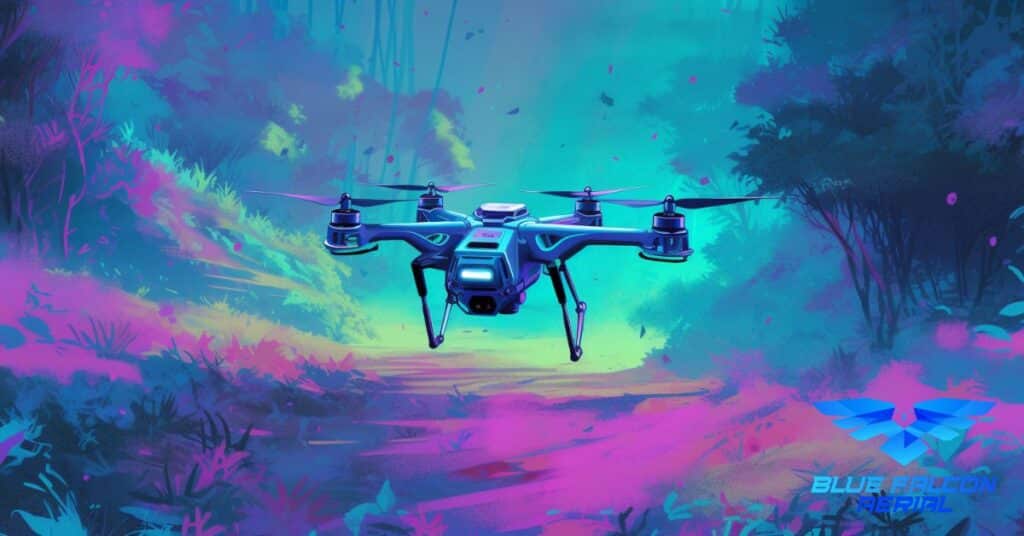In the dynamic world of drones, one name reigns supreme: DJI. This tech giant has carved an unparalleled niche, dominating the drone market with its innovative products. But in an industry fueled by rapid technological advancements and creative ingenuity, the question arises: how can emerging companies think outside the box to challenge DJI’s reign? This article explores creative and strategic solutions to dethrone DJI from its market-leading position, delving into innovative technology, niche market targeting, and powerful partnerships as key tools in reshaping the competitive landscape.
Key Takeaways
- DJI’s market dominance is built on innovation, quality, and global reach, but it leaves gaps in affordability, simplicity for beginners, and specialized applications.
- Emerging technologies like AI, extended battery life, and advanced imaging are key to challenging DJI’s position, offering opportunities to innovate in areas like swarm technology and solar-powered drones.
- Strategic partnerships and collaborations with industry leaders, academia, and government bodies can provide the necessary boost to compete effectively with DJI.
- Focusing on niche markets like agriculture, indoor inspections, or public safety allows for specialization and building a loyal customer base, reducing direct competition with DJI.
- Effective marketing and branding, with storytelling and community engagement, can help new entrants in the drone market to connect with specific audiences and differentiate themselves from DJI.

Understanding DJI’s Market Dominance
DJI, short for Da-Jiang Innovations, has not just entered the drone market; it has reshaped it. Their story is one of innovation, timing, and understanding market needs.
How DJI Achieved Its Market-Leading Position
- Innovation and Quality: DJI’s rise is attributed to its commitment to quality and innovation. They consistently introduce features that set industry standards, like advanced stabilization and obstacle avoidance.
- Meeting Market Demand: They understood early on what consumers and professionals needed, filling those gaps effectively.
- Global Reach: DJI’s expansion into global markets quickly outpaced competitors, making them a household name in the drone industry.
DJI’s Strengths and Competitive Advantages
- Brand Recognition: DJI is synonymous with drones. This recognition brings trust and a loyal customer base.
- R&D Investments: They invest heavily in research and development, staying ahead in the tech curve.
- Diverse Product Range: From hobbyist drones to professional-grade UAVs, DJI has something for everyone.
Consider the story of a small wildlife conservation team. They chose a DJI drone for its reliability and advanced features, highlighting DJI’s appeal across various sectors.
Identifying Market Gaps and Opportunities
Despite DJI’s dominance, there are market gaps and opportunities for competitors to explore.
Examination of Areas Where DJI May Be Lacking
- High Cost: DJI’s products often come with a premium price tag, potentially alienating budget-conscious consumers.
- Complexity for Beginners: Some beginners find DJI drones intimidating, indicating a market for simpler, user-friendly drones.
- Customer Service Issues: Some users have reported less-than-ideal experiences with DJI’s customer service, suggesting an area for improvement for competitors.
Potential Market Opportunities and Niches
- Budget Drones: There is a growing market for affordable drones that still offer decent quality and features.
- Specialized Drones: Drones designed for specific uses, like agricultural surveying or indoor inspections, offer a niche market.
- Enhanced Customer Experience: Focusing on superior customer service could be a differentiator.
A notable example is a startup that saw success by offering affordable, easy-to-use drones for educational purposes, a segment DJI had not fully tapped into.
By understanding DJI’s position and the existing gaps in the drone market, emerging companies can strategize to capture untapped potential and challenge the status quo.

Innovative Technology as a Game Changer
In the drone market, innovation is not just a buzzword; it’s the cornerstone of competition. Let’s delve into how embracing cutting-edge technology can level the playing field with DJI.
Embracing Emerging Technologies
- AI and Machine Learning: Incorporating AI can enable drones to perform complex tasks autonomously, like real-time data analysis and decision-making.
- Extended Battery Life: Focusing on battery innovation could lead to longer flight times, a major selling point.
- Advanced Imaging Technologies: High-resolution, multispectral, and thermal imaging can open doors to new applications, from agriculture to search and rescue.
Examples of Tech Advancements in Drones
- Swarm Technology: Imagine drones coordinating in a swarm for large-scale tasks – it’s not just science fiction but a budding reality.
- Solar-Powered Drones: Some companies are experimenting with solar-powered drones for prolonged flight times, ideal for continuous monitoring tasks.
Innovation in drones isn’t just about adding more features. It’s about finding that one feature that changes how people use drones. Like that startup which developed a drone for remote medical deliveries, transforming healthcare access in rural areas.
Strategic Partnerships and Collaborations
In a David vs. Goliath scenario, strategic alliances can be a slingshot. Partnering with the right entities can provide a significant boost in challenging DJI’s dominance.
The Role of Partnerships in Enhancing Market Position
- Industry Collaborations: Teaming up with industry leaders in sectors like telecommunications or imaging can lead to innovative integrations.
- Academic Partnerships: Collaborating with universities can drive R&D, leading to breakthroughs in drone technology.
- Government and Regulatory Bodies: Working with these entities can aid in navigating legal landscapes and opening up new markets.
Case Studies of Successful Collaborations
- Collaboration for Public Safety: Consider a company that partnered with a public safety department to develop drones specifically for emergency response – a match that benefited both parties.
- Academic Alliance: A drone startup working with a university’s robotics lab made groundbreaking advancements in autonomous flight.
Strategic partnerships are about complementing strengths. It’s like a tech firm collaborating with a nature conservation group. Together, they developed a drone that could monitor wildlife populations more effectively than any tool before.
By integrating innovative technology and forging strategic partnerships, companies can not only compete with DJI but also redefine what drones can do. It’s about seeing where the market is heading and getting there first – or in a completely different, groundbreaking way.
Focusing on Niche Markets
Targeting niche markets can be a strategic move in establishing a strong foothold against DJI. Let’s explore how specialization can create unique opportunities.
Importance of Specializing in Niche Markets
- Unique Needs: Every niche has specific requirements that mainstream products might not meet.
- Loyal Customer Base: Niche markets often lead to a more dedicated and engaged customer base.
- Reduced Competition: Specializing in a niche can mean fewer competitors, unlike broader markets.
Examples of Niche Market Success
- Agricultural Drones: Consider a company that developed drones specifically for precision agriculture, offering features tailored for farm monitoring.
- Indoor Inspection Drones: Another example is a startup focusing on drones for indoor inspections, solving the problem of navigating tight spaces where traditional drones struggle.
Each niche has its own story. Like a drone startup that carved out a market in architectural conservation, their drones could access and scan historical structures without the risk of damage.
Leveraging Marketing and Branding
In a market dominated by DJI, smart marketing and effective branding can make a significant difference. It’s about connecting with customers and standing out.
Power of Effective Marketing and Branding Strategies
- Storytelling: Share stories that resonate with your target audience. It’s not just about selling a product; it’s about sharing a vision.
- Brand Identity: Establish a strong brand identity that reflects your company’s values and mission.
- Engaging Campaigns: Create campaigns that engage and intrigue your audience.
Examples of Transformative Marketing Campaigns
- Community Engagement: Think of a drone company that launched a campaign showcasing how their drones help in wildlife conservation, resonating deeply with environmentally conscious consumers.
- Influencer Partnerships: Another strategy is partnering with influencers in specific sectors to showcase the practical uses of drones, like in adventure sports or filmmaking.
Remember, good marketing tells a story that people want to be a part of. It’s like when a new company launched a campaign highlighting how their drones could capture stunning travel footage, appealing to the wanderlust in everyone.
In sum, by focusing on niche markets and leveraging marketing and branding, companies can create a distinct space in the drone market. It’s about understanding where you can make the biggest impact and reaching out to those who will appreciate your unique value proposition.
While DJI’s dominance in the drone market is formidable, it is not unassailable. By leveraging innovative technology, focusing on niche markets, and forging strategic partnerships, new and existing companies can carve out their own space in the industry. It’s about finding the unique value proposition and executing it with precision. For those seeking to dive deeper into the nuances of building and growing a successful drone business, our comprehensive guide, Soaring High: A Comprehensive Guide to Building and Growing Your Drone Business, offers invaluable insights. Additionally, if you’re looking for expert drone services or wish to discuss potential business strategies, don’t hesitate to contact us at Blue Falcon Aerial. The sky’s the limit when innovative minds work to disrupt the status quo.




